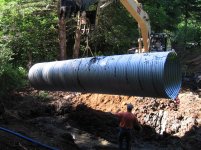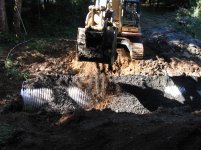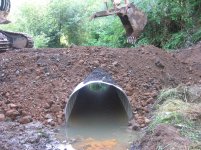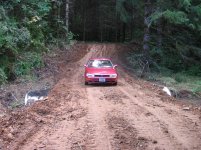If you can think of this channel as a spillway from a pond, you could gauge what needs to be done, or at least consider some options. I know, there's not actually a pond this is flowing from, but the (mostly) dry creek acts as a spillway would if a pond were being overflowed.
If you go to any online topo map or similar website, you should be able to get a good guess of the area that drains into this creek. Plug that area into this formula (you can use an online conversion tool to change any area measurement into acres):
Q = C I A
where: Q = peak discharge, corresponding to a given
rainfall intensity, ft.3/sec;
C = runoff coefficient
I = rain intensity, in/hr;
A = catchment area (acres)
To determine a typical case scenario, the "100 year rain" or what is believed to a rainfall amount that comes about once every 100 years:
hdsc.nws.noaa.gov/hdsc/pfds/other/mn_pfds.html
Take the number you find at the website and insert it as I in the formula. (the site also give expected rainfall amounts for other storms, like maybe every 10 yrs, 25 yrs, etc)
This table will help you determine C for the formula:
Values of Runoff Coefficient (C) for Rational Formula
http://water.me.vccs.edu/courses/CIV246/table2_print.htm
Land Use C Land Use C
Business: Downtown areas Neighborhood areas 0.70 - 0.95 0.50 - 0.70 Lawns: Sandy soil, flat, 2% Sandy soil, avg., 2-7% Sandy soil, steep, 7% Heavy soil, flat, 2% Heavy soil, avg., 2-7% Heavy soil, steep, 7% 0.05 - 0.10 0.10 - 0.15 0.15 - 0.20 0.13 - 0.17 0.18 - 0.22 0.25 - 0.35
Residential: Single-family areas Multi units, detached Munti units, attached Suburban 0.30 - 0.50 0.40 - 0.60 0.60 - 0.75 0.25 - 0.40 Agricultural land: Bare packed soil *Smooth *Rough Cultivated rows *Heavy soil, no crop *Heavy soil, with crop *Sandy soil, no crop *Sandy soil, with crop Pasture *Heavy soil *Sandy soil Woodlands 0.30 - 0.60 0.20 - 0.50 0.30 - 0.60 0.20 - 0.50 0.20 - 0.40 0.10 - 0.25 0.15 - 0.45 0.05 - 0.25 0.05 - 0.25
Industrial: Light areas Heavy areas 0.50 - 0.80 0.60 - 0.90 Streets: Asphaltic Concrete Brick 0.70 - 0.95 0.80 - 0.95 0.70 - 0.85
Parks, cemeteries 0.10 - 0.25 Unimproved areas 0.10 - 0.30
Playgrounds 0.20 - 0.35 Drives and walks 0.75 - 0.85
Railroad yard areas 0.20 - 0.40 Roofs 0.75 - 0.95
*Note: The designer must use judgement to select the appropriate "C" value within the range. Generally, larger areas with permeable soils, flat slopes and dense vegetation should have the lowest "C" values. Smaller areas with dense soils, moderate to steep slopes, and sparse vegetation should assigned the highest "C" values.
Once you have the numbers, multiply C x I X A this gives you expected maximum flow. I believe these sites also have more info on picking pipe sizes, etc.
The charts are a lot easier to read than what I can copy/paste, too.



